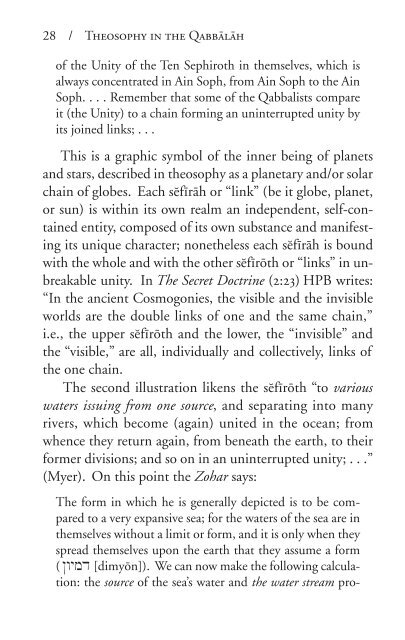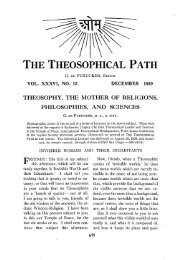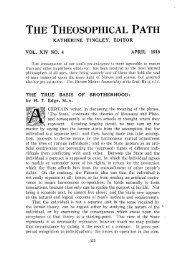Theosophy in the Qabbālāh - The Theosophical Society
Theosophy in the Qabbālāh - The Theosophical Society
Theosophy in the Qabbālāh - The Theosophical Society
You also want an ePaper? Increase the reach of your titles
YUMPU automatically turns print PDFs into web optimized ePapers that Google loves.
28 / <strong><strong>The</strong>osophy</strong> <strong>in</strong> <strong>the</strong> Qabbãlãh<br />
of <strong>the</strong> Unity of <strong>the</strong> Ten Sephiroth <strong>in</strong> <strong>the</strong>mselves, which is<br />
always concentrated <strong>in</strong> A<strong>in</strong> Soph, from A<strong>in</strong> Soph to <strong>the</strong> A<strong>in</strong><br />
Soph. . . . Remember that some of <strong>the</strong> Qabbalists compare<br />
it (<strong>the</strong> Unity) to a cha<strong>in</strong> form<strong>in</strong>g an un<strong>in</strong>terrupted unity by<br />
its jo<strong>in</strong>ed l<strong>in</strong>ks; . . .<br />
This is a graphic symbol of <strong>the</strong> <strong>in</strong>ner be<strong>in</strong>g of planets<br />
and stars, described <strong>in</strong> <strong>the</strong>osophy as a planetary and/or solar<br />
cha<strong>in</strong> of globes. Each sêfîrãh or “l<strong>in</strong>k” ( be it globe, planet,<br />
or sun) is with<strong>in</strong> its own realm an <strong>in</strong>dependent, self-conta<strong>in</strong>ed<br />
entity, composed of its own substance and manifest<strong>in</strong>g<br />
its unique character; none<strong>the</strong>less each sêfîrãh is bound<br />
with <strong>the</strong> whole and with <strong>the</strong> o<strong>the</strong>r sêfîrõth or “l<strong>in</strong>ks” <strong>in</strong> unbreakable<br />
unity. In <strong>The</strong> Secret Doctr<strong>in</strong>e (2:23) HPB writes:<br />
“In <strong>the</strong> ancient Cosmogonies, <strong>the</strong> visible and <strong>the</strong> <strong>in</strong>visible<br />
worlds are <strong>the</strong> double l<strong>in</strong>ks of one and <strong>the</strong> same cha<strong>in</strong>,”<br />
i.e., <strong>the</strong> upper sêfîrõth and <strong>the</strong> lower, <strong>the</strong> “<strong>in</strong>visible” and<br />
<strong>the</strong> “visible,” are all, <strong>in</strong>dividually and collectively, l<strong>in</strong>ks of<br />
<strong>the</strong> one cha<strong>in</strong>.<br />
<strong>The</strong> second illustration likens <strong>the</strong> sêfîrõth “to various<br />
waters issu<strong>in</strong>g from one source, and separat<strong>in</strong>g <strong>in</strong>to many<br />
rivers, which become (aga<strong>in</strong>) united <strong>in</strong> <strong>the</strong> ocean; from<br />
whence <strong>the</strong>y return aga<strong>in</strong>, from beneath <strong>the</strong> earth, to <strong>the</strong>ir<br />
former divisions; and so on <strong>in</strong> an un<strong>in</strong>terrupted unity; . . .”<br />
(Myer). On this po<strong>in</strong>t <strong>the</strong> Zohar says:<br />
<strong>The</strong> form <strong>in</strong> which he is generally depicted is to be compared<br />
to a very expansive sea; for <strong>the</strong> waters of <strong>the</strong> sea are <strong>in</strong><br />
<strong>the</strong>mselves without a limit or form, and it is only when <strong>the</strong>y<br />
spread <strong>the</strong>mselves upon <strong>the</strong> earth that <strong>the</strong>y assume a form<br />
( -wymd [dimyõn]). We can now make <strong>the</strong> follow<strong>in</strong>g calculation:<br />
<strong>the</strong> source of <strong>the</strong> sea’s water and <strong>the</strong> water stream pro-













